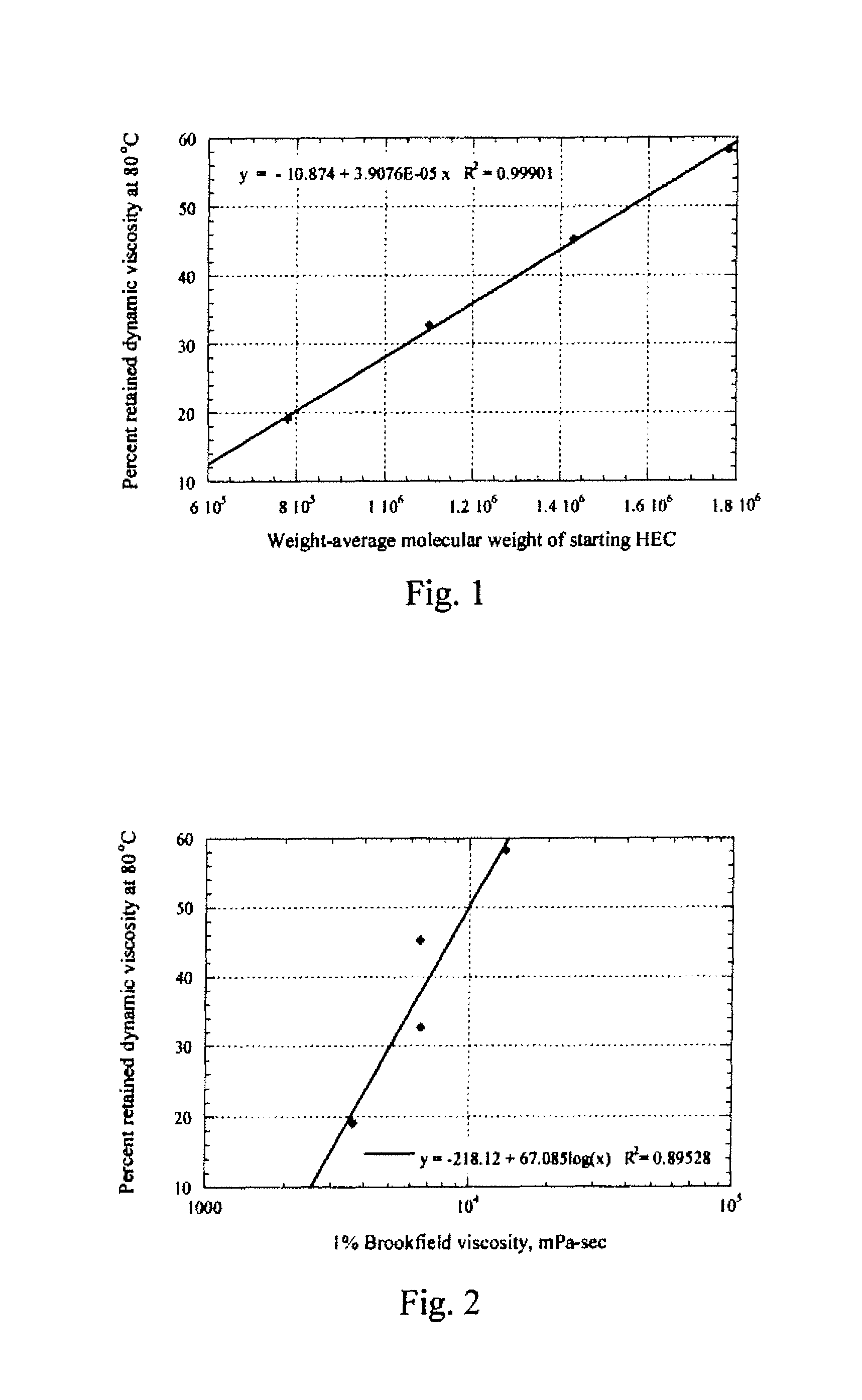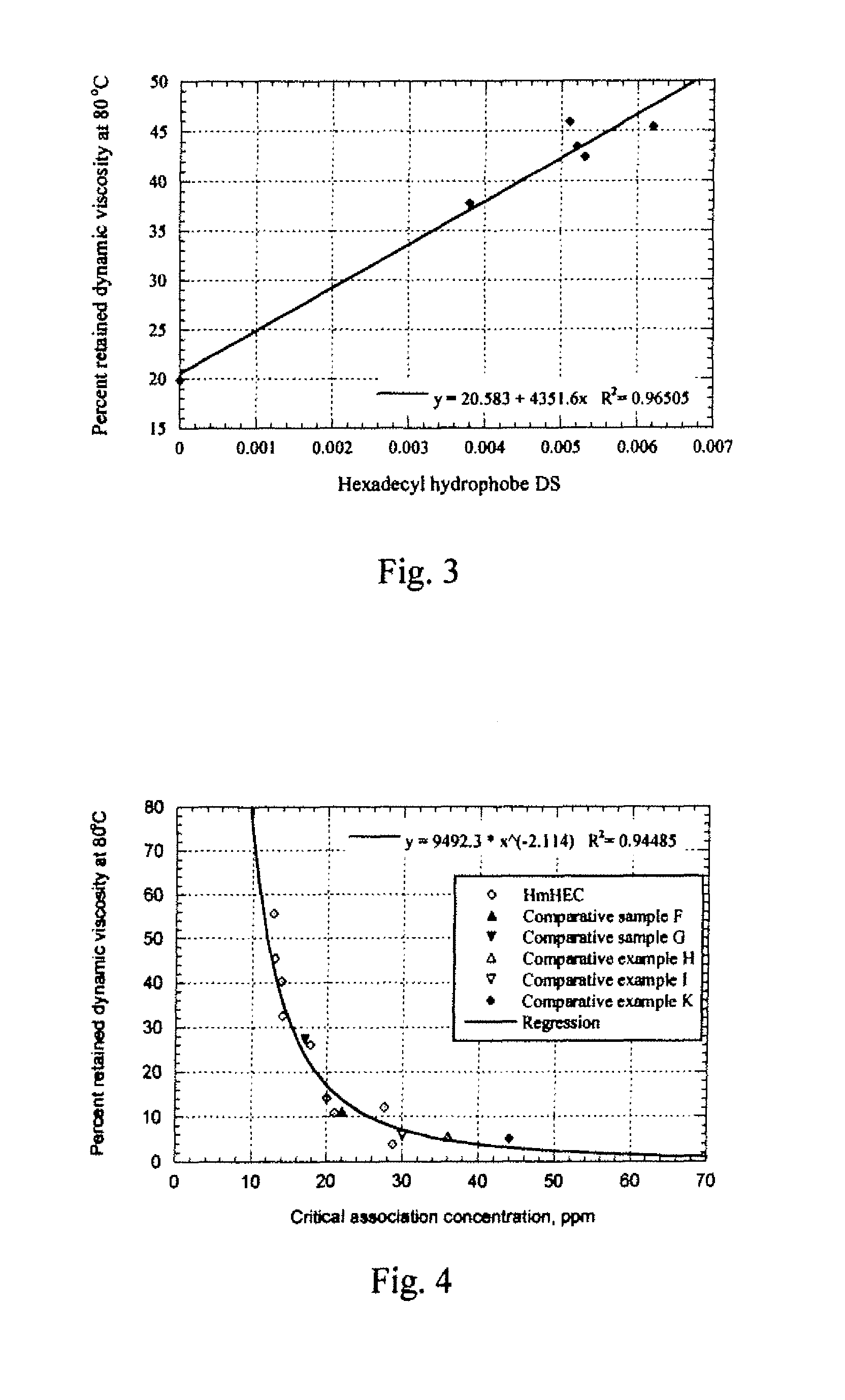Nonionic hydrophobically substituted cellulose ethers
a technology of hydrophobic substitution and cellulose ether, which is applied in the direction of lubricant composition, sealing/packing, borehole/well accessories, etc., can solve the problems of high undesirable thermal thinning, many of the known water-soluble or water-swellable cellulose ethers used, and exhibit a reversible loss of viscosity. , to achieve the effect of reducing the degree of thermal thinning
- Summary
- Abstract
- Description
- Claims
- Application Information
AI Technical Summary
Benefits of technology
Problems solved by technology
Method used
Image
Examples
examples 1-50
and A-K
Measurement of Retained Dynamic Viscosity % η80 / 25, Storage Modulus at 25° C. and Retained Storage Modulus % G′80 / 25
[0054]A TA Instruments AR-2000 oscillatory rheometer fitted with a cup and bob (Couette) geometry was used to measure the solution viscosity of various polymer solutions at elevated temperatures. The temperature was ramped up from 25.0° C. to 100.0° C. at a rate of 2.0° C. / minute, with the fixed frequency of 0.5 Hz and the fixed applied stress of 0.1809 Pa (10 μN-m). The storage & loss moduli and phase angle of 1% aqueous solutions of selected cellulose ethers measured by the rheometer were recorded as a function of temperature. To evaluate the data, the dynamic solution viscosities (η′) at 25° C. and 80° C. were calculated by dividing the loss modulus by the frequency (η′=G″ / ω, where ω=π radians / second). The percent retained dynamic viscosity at 80° C. (% η80 / 25) is obtained by dividing the dynamic solution viscosity at 80° C. by the dynamic solution viscosity...
example 10
Preparation of HmHEC from CELLOSIZE HEC
[0068]A 500 ml resin kettle was fitted with a mechanical stirring paddle, a nitrogen inlet, a rubber serum cap, and a reflux condenser connected to a mineral oil bubbler. The resin kettle was charged with 33.28 g (30.00 g contained) CELLOSIZE® HEC QP-30,000H, 173 g of isopropyl alcohol, and 27 g of distilled water. CELLOSIZE® HEC QP-30000H is a hydroxyethyl cellulose commercially available from The Dow Chemical Company. While stirring the mixture, the resin kettle was purged with nitrogen for one hour to remove any entrained oxygen in the system. While stirring under nitrogen, 4.00 g of 50% aqueous sodium hydroxide solution were added dropwise over five minutes using a syringe. The mixture was then allowed to stir for 30 minutes under nitrogen.
[0069]A solution of 4.00 g of 1-bromohexadecane in 10 mL of isopropyl alcohol was added by syringe to the mixture under nitrogen (0.11 moles of 1-bromohexadecane per mole of HEC). Heat was then applied us...
example 22
Preparation of HmHEC from Cellulose
[0071]A three pint, glass Cemco™ pressure reactor was charged with 31.90 g of single cut Borregaard™ UHV-17 wood pulp (30.00 g contained), 350.4 g of isopropyl alcohol and 54.6 g of distilled water. The mixture was stirred for one hour while purging the headspace of the reactor with nitrogen at a rate of 500 mL / min to remove any entrained oxygen. The reactor was fitted with an ice water condenser to prevent evaporative losses of the diluent during the nitrogen purge. The temperature of the slurry was adjusted to 32° C. using a water bath.
[0072]After purging for one hour, 46.4 g of 22% (by weight) aqueous sodium hydroxide solution (1.38 moles of sodium hydroxide per anhydroglucose unit) were added to the slurry by syringe, and the temperature of the slurry increased from 32° C. to 35° C. The slurry was stirred for one hour at 35° C., while continuing the nitrogen headspace purge. A charge of freshly distilled ethylene oxide (42.0 g, 5.15 moles of et...
PUM
| Property | Measurement | Unit |
|---|---|---|
| storage modulus | aaaaa | aaaaa |
| Brookfield viscosity | aaaaa | aaaaa |
| storage modulus | aaaaa | aaaaa |
Abstract
Description
Claims
Application Information
 Login to View More
Login to View More - R&D
- Intellectual Property
- Life Sciences
- Materials
- Tech Scout
- Unparalleled Data Quality
- Higher Quality Content
- 60% Fewer Hallucinations
Browse by: Latest US Patents, China's latest patents, Technical Efficacy Thesaurus, Application Domain, Technology Topic, Popular Technical Reports.
© 2025 PatSnap. All rights reserved.Legal|Privacy policy|Modern Slavery Act Transparency Statement|Sitemap|About US| Contact US: help@patsnap.com



